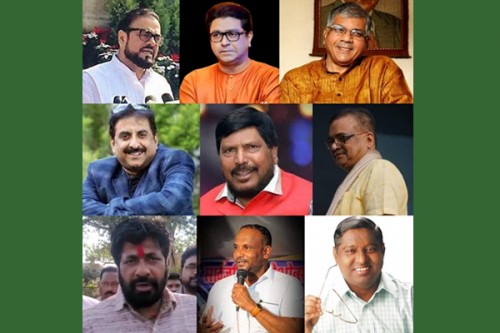(POLITICS PACKAGE) Fringe political parties, reviled & wooed, bank on minuscule vote banks

Mumbai, July 22 (IANS) In the rainbow-coloured Indian democracy, hundreds of big and small political parties representing varied ideologies, vote banks, pressure groups or interests seem to co-exist, including in Maharashtra.
There are the ‘big fish’ which singly or jointly with others, appear to rule the roost either at the national level or state level, and there are many ‘small’ or even ‘tiny’ fish which cling to one or the other groups to ensure their survival.
Maharashtra has a handful of big ones – the Bharatiya Janata Party, Congress, Shiv Sena, Shiv Sena (UBT), the two factions of the Nationalist Congress Party led by Sharad Pawar and Ajit Pawar.
The string of smaller ones comprise the Bahujan Vikas Aghadi, Peasants & Workers Party, All India Majlis-e-Ittehadul Muslimeen, Republican Party of India (A), CPI (Marxist), Prahar Janshakti Party (PJP), Swabhimani Party, Samajwadi Party, Rashtriya Samaj Party, Jan Surajya Shakti, Maharashtra Navnirman Sena and Vanchit Bahujan Aghadi (with no elected leader).
Of these, some have tagged onto the ruling Shiv Sena-BJP-NCP (AP), others are aligned with the Opposition Maha Vikas Aghadi of Congress-Shiv Sena (UBT)-NCP (SP).
The remaining are ‘unattached’, fence-sitters who jump whenever – or wherever – the grass is greener, making them always suspect in the eyes of the bigger players.
Relegated largely to ‘supporting roles’, the bigger parties hope that occasionally the smaller comrades may help sway crucial sections of the voters like Dalits, farmers, women, workers, youth, etc, though it may not always work.
A small outfit leader feels that the arrangement suits both in the ‘political numbers game’ as every vote can make or mar a regime, citing the example of April 1999 – when the then Prime Minister Atal Bihari Vajpayee lost power by a single vote in Parliament.
“Hence, in the modern era, the ruling and opposition try to keep as many parties as possible on their side – the NDA at the Centre has around 38 parties while the other side has 26 – and there are quite a few ‘unallied’ ones around,” he explained.
Fortunately, Maharashtra has never encountered a 1999-like situation, but the latter arguments are valid as both the ruling and opposition vie to pocket as many small parties as possible to ‘look and sound’ puffed up – irrespective of public sentiments.
Those who support the ruling side are also ‘looked after’ – ministerial berths, important cabinet-rank positions, other plum appointments, heading various organisations or small banks, domestic or foreign jaunts or other perks, hobnobbing with the top brass when there are ‘double-engine’ governments of the same party in the state and Centre, etc.
One such example is RPI (A) president and Union MoS Ramdas Athawale – who managed to always remain with the ruling side from 1990 - first with the Congress till 2011, then hitched to the Shiv Sena-BJP, picking up rewards like ministries at the state and Centre.
There’s PJP leader Kadu who became a minister in the MVA regime of ex-CM Uddhav Thackeray, but was not so lucky under the current CM Eknath Shinde.
Founded in 1948, the PWP’s current general secretary is Jayant P. Patil, MLC. The party has managed to retain its small stronghold with Lok Sabha or Rajya Sabha MPs, MLAs, MLCs regularly elected in its 75-year existence, either keeping independent or aligning with the left-of-centre groups; once it even had a Leader of Opposition (1962-1972), and other important assignments.
The 17-year-old MNS of Raj Thackeray has yet to become a politically mature adult, and currently has a lone MLA, compared with an impressive 13 in 2009, largely due to the party’s oscillating or vacillating stance at various occasions on different issues, and still away from the mainstream, its on the ‘pavement’.
The CPI (Marxist), Samajwadi Party and AIMIM are branches of parties spread in multiple states but enjoy a pan-India image, and have several elected leaders at the local, state or national level.
An NCP (SP) leader said that Maharashtra has always been a politically stable state but this took a beating after 2019 owing to the belligerent BJP which was unwilling to stay out of power.
“They resorted to hijacking power (2-man, 80-hour regime of November 2019), then toppling the government (June 2022), breaking parties (Shiv Sena June 2022, NCP in July 2023), weakening the allies while remaining ensconced with its own flock,” he said, declining to be quoted owing to the current fluid scenario.
However, state Congress president Nana Patole has been more direct saying that the people are fed up with the BJP’s unprincipled politics and will show them the door in 2024.
Shiv Sena (UBT)’s Sanjay Raut targets directly - he has predicted on at least three occasions that “Shinde’s days are numbered, Ajit Pawar will become the CM soon”.
It remains to be seen for how long some of the smaller parties – who are publicly courted but privately cursed – remain relevant or continue to exploit miniscule vote-banks for cornering privileges disproportionate to their influence.

|

|

